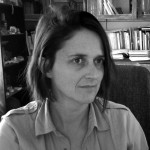
Fritha Langerman
University of Cape Town
fritha.langerman@uct.ac.za
www.michaelis.uct.ac.za
Biography
Fritha Langerman is an Associate Professor at the University of Cape Town, teaching printmaking at the Michaelis School of Fine Art. She trained at the same institution (BAFA, MFA) and is currently registered for a PhD. Her research is of an interdisciplinary nature and research interests include curatorship; scientific representation of the body and the display and ordering of information. She has exhibited nationally and internationally and has number of public commissioned works, including the 3rd Cape Town Public Sculpture Commission and numerous installations at the University of Cape Town. Her awards include a UCT Junior Fellow’s Award (2007) and the UCT Creative Works Award (2010). Her recent solo exhibitions Subtle Thresholds( 2009 – 2010) and R-A-T (2012-13) at the South African Museum are concerned with display within natural history museums.
Academic Paper
Cover to Cover: The Contribution of the Book to the Reproduction of Linear, Hierarchical Models of Natural History.
While the museum of natural history has been both the public front and the repository of collections, the natural history book has been the interface at which collections have been anatomised, ordered and translated. From the initial Renaissance collections to the contemporary museum, the relationship between objects and paper publications has been closely connected. Careful analysis and observation of study collections resulted in companion ‘paper museums’ of books and folios and in some instances the book can be seen as becoming the archive of the physical collection. With its portability it stands for the material archive, overriding the significance of the collection itself. Illustrations become definitive, while the collection often remains impenetrable, inaccessible to the public beyond the boundaries of accession and interpretation by those initiated illustrators.
My framing interest in this area is the perpetuation of linear, hierarchical models of speciation within natural history museums. I believe that museum display has not responded to contemporary ways of understanding speciation or knowledge, choosing to adhere to a visual methodology that recalls tree-like, discrete divisions of nature, deferring to a Christian symbolic inheritance in both the iconography of evolution and display. In this paper I wish to focus on the impact of Christianity on the form of the book and suggest that, when seen within the context of books of natural history, ancient notions of hierarchy of being – the scala naturae – are resident within its structure. The book has provided the instructive model on which display within museums has been based. This idea is complicated by the presence of images within books and two questions that emerge are: how did the introduction of illustrated texts change the reception of ideas that were previously presented solely as text, and what is the role of texts and the book as a form in the transmission of scientific knowledge?
